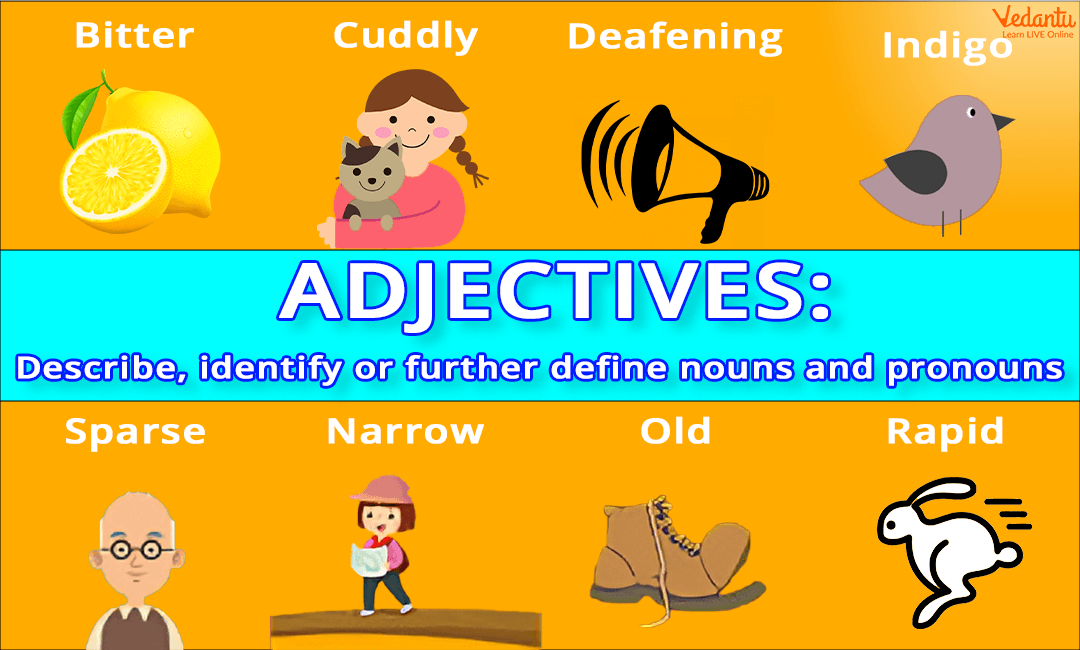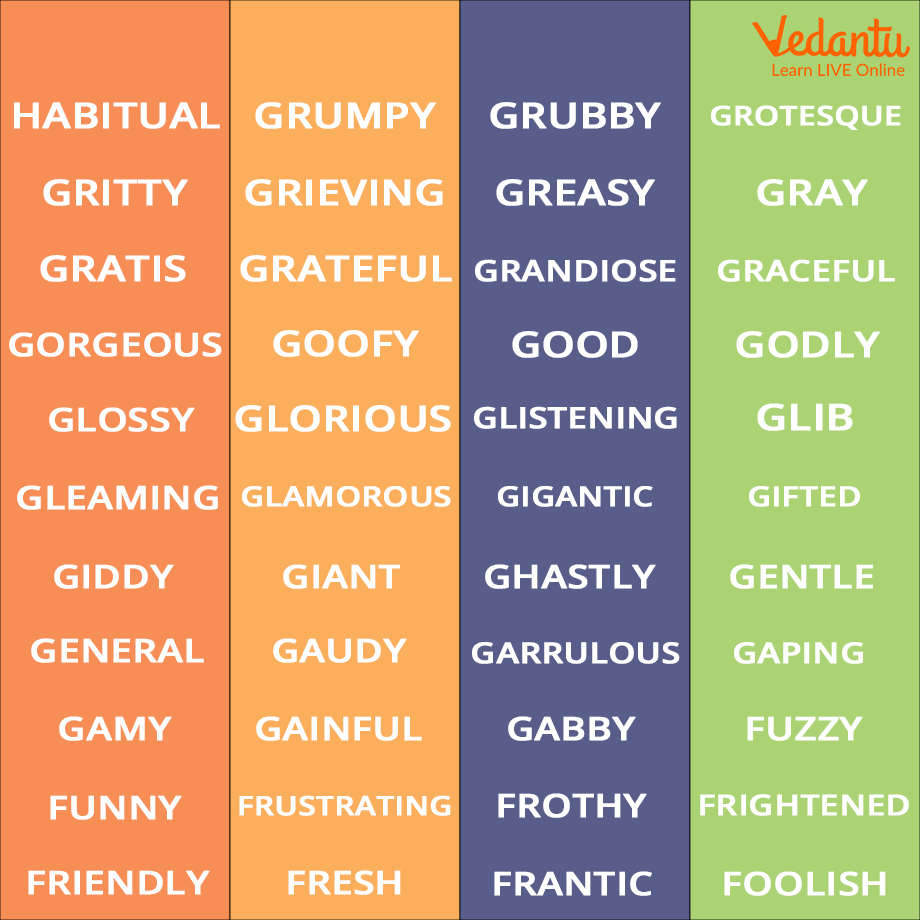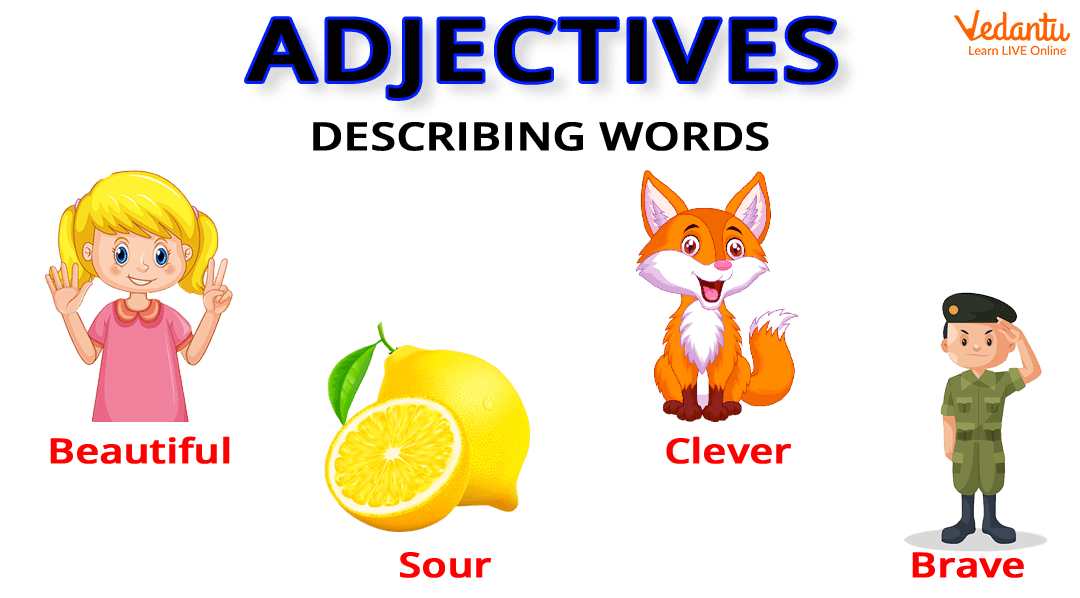




Types of Adjectives with Examples to Improve Your Skills
An adjective is a word that is used to describe something. Have you ever thought about it? How would you describe a pretty dress or enjoy a beautiful sunrise? To complete this, we put adjectives that add further description to nouns. You can understand adjectives through examples. To learn the uses of adjectives, you should spend time reading examples of adjectives and their uses in sentences. Read the following article to learn about adjectives with fun. We have created a list of adjectives for students focusing on important points for their better marks. You will get a list of adjectives and examples that will help you to use adjectives in sentences. Also, this page contains an adjectives list for kids.

Adjectives List
A list of adjectives is given below.

Adjective List
Adjective list for kids
Examples of Adjectives in Sentences
See the use of adjectives in sentences.
The taste of lemon is very sour.
The girl is wearing a beautiful dress.
Fox is a clever animal.
Soldiers are brave people.

Adjectives Describing Words
Adjectives to Describe Taste
Did you know how you describe any food or taste that you liked? You use the following adjectives to describe the taste.
Adjectives to Describe Touch
See the list of adjectives we use when we want to describe touch. You can use different adjectives to describe touch.
Adjectives to Describe Sound
Depending upon the intensity of sounds, we describe them. They can be a whisper or blaring and anything in between.
Adjectives to Describe Colour
Yes! There are some adjectives in English that are used to describe colours. This world is full of colours. Let’s explore the list of adjectives that describe colours.
Adjectives to Describe Size and Shape
The list of adjectives are as follows, that are used to describe the size and shape of something.
Adjectives to Describe Time
There are a lot of adjectives that are used to describe time. The list of some adjectives describing time is given below.
Adjectives to Describe an Amount
The examples of some adjectives are given below, that are used in English to describe an amount.
Adjectives to Describe an Emotion
The emotions of people are important and they need to be described. Some adjectives are given below, that are used to describe emotions.
Adjectives To Describe Appearance
The lists of some adjectives are provided here that describe appearance.
Adjectives to Describe Situations
Some descriptive adjectives are as follows, that are often used when talking about situations.
Adjectives list A-Z
Conclusion
Hence, the above article is useful for the children to learn about adjectives. The list of adjectives is provided for different situations when we use adjectives. Hence, kids will get an idea of where and how to use adjectives.
Test your Knowledge of Adjectives
1. Identify the Adjective:
In the sentence "The small, furry dog slept quietly," which words are adjectives?
2. Choose the Correct Adjective:
Choose the most suitable adjective to complete the sentence: "She wore a __________ dress to the party."
a) big
b) quickly
c) joyful
d) sing
3. Fill in the Blanks:
Fill in the blanks with appropriate adjectives: "The __________ cat climbed the __________ tree with great agility."
4. Comparative and Superlative Forms:
Write the comparative and superlative forms of the adjective "happy."
5. Adjective Order:
Arrange the adjectives in the correct order in this sentence: "The (colour/size/quality) (adjective) (noun)." For example: "a large blue beautiful vase."
6. Identify the Type of Adjective:
In the sentence "He gave a generous donation to the charity," identify the type of adjective used.
7. Use Adjectives in Sentences:
Create a sentence using the adjectives "elegant," "old," and "wooden."
8. Adjective-Noun Agreement:
Choose the correct adjective to match the noun: "The __________ (friendly/friend) teacher helped the students."
9. Replace the Adjective:
Replace the adjective in the sentence with a synonym: "The movie was very interesting."
10. Adjective Phrases:
Identify and underline the adjective phrase in the sentence: "The house, filled with colourful paintings, stood on the hill."
Find Out if you Got them Right from the Answers Below.
1. Identify the Adjective:
Small, furry
2. Choose the Correct Adjective:
a) big
3. Fill in the Blanks:
The playful cat climbed the tall tree with great agility.
4. Comparative and Superlative Forms:
Comparative: happier
Superlative: happiest
5. Adjective Order:
Example: "a large beautiful blue vase."
6. Identify the Type of Adjective:
Generous (descriptive adjective)
7. Use Adjectives in Sentences:
Example: "She admired the elegant old wooden chair."
8. Adjective-Noun Agreement:
The friendly teacher
9. Replace the Adjective:
Example: "The movie was very engaging."
10. Adjective Phrases:
"The house, filled with colourful paintings, stood on the hill."
Review your Understanding of Adjectives for Children
Exercise 1: Identify the Adjective
Instructions: Underline the adjective in each sentence.
The sky is blue.
She has a fluffy cat.
The tall tree touches the clouds.
My new shoes are shiny.
The cake is delicious.
Exercise 2: Add an Adjective
Instructions: Add an adjective to each sentence to make it more interesting.
The dog barked at the stranger.
I saw a butterfly.
The car drove down the street.
She wore a dress.
The boy ran to the park.
Exercise 3: Match the Noun with the Adjective
Instructions: Match the noun in the first column with the best adjective in the second column.
Exercise 4: Use the Right Adjective
Instructions: Choose the correct adjective to complete the sentence.
The water is (hot, loud).
She has a (cold, purple) hat.
The (shiny, rough) diamond sparkled in the light.
He is a (happy, tall) boy.
The music was (funny, loud) at the concert.
Exercise 5: Create Your Own Sentences
Instructions: Write a sentence using each of the following adjectives.
Sunny
Brave
Huge
Tasty
Fast
Check the answers below:
Exercise 1: Identify the Adjective
The sky is blue.
She has a fluffy cat.
The tall tree touches the clouds.
My new shoes are shiny.
The cake is delicious.
Exercise 2: Add an Adjective
The big dog barked at the stranger.
I saw a colourful butterfly.
The fast car drove down the street.
She wore a beautiful dress.
The young boy ran to the park.
(Note: The added adjectives can vary; these are just examples.)
Exercise 3: Match the Noun with the Adjective
Exercise 4: Use the Right Adjective
The water is hot.
She has a purple hat.
The shiny diamond sparkled in the light.
He is a happy boy.
The music was loud at the concert.
Exercise 5: Create your own Sentences
Since this exercise involves creating original sentences, here are some examples:
Sunny: It was a sunny day at the beach.
Brave: The brave firefighter rescued the cat.
Huge: The elephant is huge and strong.
Tasty: The pizza was tasty and cheesy.
Fast: The rabbit is fast when it runs.
Takeaways from this Page
Adjectives provide detailed descriptions and add depth to language by specifying qualities, quantities, and characteristics of nouns.
Understanding different types of adjectives—descriptive, quantitative, demonstrative, and possessive—helps in using them effectively to convey precise meanings.
Adjectives in English often follow a specific order when used together, such as quantity, quality, size, age, shape, colour, origin, material, and purpose, which enhances clarity in writing and speech.
Adjectives change form to compare different items (comparative) or to denote the highest degree of quality (superlative), which is essential for making comparisons and highlighting extremes.
Using a variety of adjectives enriches writing and speech, making descriptions more vivid and engaging.
FAQs on Master English Adjectives: The Essential List for Students
1. When should kids learn about adjectives?
Parents can introduce adjectives to toddlers through examples and simple sentences. This early exposure helps children understand the role of adjectives in describing objects, enhancing their language skills and comprehension.
2. Why is it important for children to practice adjectives?
Practising adjectives is crucial for solidifying understanding and usage. Regular practice helps children learn how to describe objects and experiences more vividly, improving their overall language proficiency and communication skills.
3. How can I make learning adjectives fun for kids?
Use interactive activities like adjective scavenger hunts, descriptive storytelling, and games that involve matching adjectives with nouns. Incorporating visuals and hands-on activities can make learning more engaging.
4. What are some simple ways to explain adjectives to young children?
Use everyday objects and describe them using adjectives (e.g., "The fluffy cat," "The big red ball"). Show how adjectives add detail to sentences and make descriptions more interesting.
5. At what age should children start using adjectives in their speech?
Children typically begin using adjectives around ages 2-3. At this stage, they might start using basic adjectives to describe familiar objects and experiences.
6. What are some examples of adjectives suitable for beginner learners?
Simple adjectives like big, small, happy, sad, red, and soft are ideal for beginners. These words help children understand basic descriptive concepts.
7. How can teachers incorporate adjectives into their lesson plans?
Teachers can integrate adjectives into lessons through descriptive writing exercises, reading stories with rich descriptions, and using interactive activities that emphasise adjective use.
8. What role do adjectives play in enhancing storytelling for children?
Adjectives enrich storytelling by providing vivid descriptions of characters, settings, and events, making the stories more engaging and helping children visualize and connect with the content.
9. How can parents support their child's learning of adjectives at home?
Parents can encourage their children to use adjectives in daily conversations, read books with descriptive language, and play games that involve identifying and using adjectives.
10. What common mistakes should be avoided when teaching adjectives to kids?
Avoid overwhelming children with too many adjectives at once. Instead, introduce them gradually and focus on practical, everyday examples. Ensure they understand the difference between adjectives and other parts of speech to prevent confusion.
11. Examples of Adjectives from the letter Y.
Y adjectives list
Adjective | Example Sentence |
Yellow | The yellow flowers brightened up the room. |
Young | The young boy played in the park. |
Yummy | The cookies were yummy. |
Yawning | The yawning child looked sleepy. |
Yucky | The medicine tasted yucky. |
Yelling | She was yelling loudly at the game. |
Yearly | We have a yearly family reunion. |
Yonder | The mountains yonder are covered in snow. |
12. Can you give 5 adjectives for children to use in sentences?
Happy, big, colourful, soft, and noisy.
















